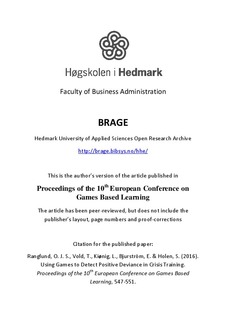Using Games to Detect Positive Deviance in Crisis Training
Journal article, Peer reviewed
Permanent lenke
http://hdl.handle.net/11250/2432980Utgivelsesdato
2016Metadata
Vis full innførselSamlinger
Sammendrag
Using games for learning has been advocated by academics like Egenfeldt-Nielsen, Gee and Prensky for several years (Egenfeldt-Nielsen, 2007; Gee, 2003; Prensky, 2001). A game is defined as: ”… a system in which players engage in an artificial conflict, defined by rules, that results in a quantifiable outcome”(Salen & Zimmermann, 2004). When training crisis both in organizational settings and in education, the “quantifiable outcome” will be less important and the game will thus more be used as a simulation, which is defined as: “… something that is made to look, feel, or behave like something else especially so that it can be studied or used to train people”(Merriam-Webster, 2015). After the gameplay, it is important to what Schön refers to as “reflect upon practice”(Schön, 1987, 1991). This will support the learning process. This is similar to the process of “after action review” used in the Military (von der Oelsnitz & Busch, 2006). During “after action reviews” the focus is on what could be improved from the actions. However, always pointing out what went wrong and analyzing the situations with a focus on the negative outcomes can be exhausting. Many issues will have been undertaken in an exemplary way with good results. Also, sometimes the outcome will be positive even if all signs pointed towards failure(Vold & Kiønig, 2015). This can be defined as Positive Deviance. Positive Deviance (hereafter called PD) is about exploring the deviants that in spite of different difficulties, they succeed (Singhal, Buscell, & Lindberg, 2010). Using PD is thus a way of looking at an issue from a different angle, and rather focus on what actually works and see if it is possible to transfer any behaviors or conditions to the areas that needs improvement. It is about analyzing and singling out the key features of what “works” and working out what of this can be transferred to other areas, and how (Singhal et al., 2010). This paper will discuss how PD can be used for learning purposes as a part of the learning process when using games and after gameplay.

